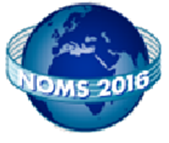Program
SESSION: COMMUNICATION & MOBILITY (Apr, 25, 14:00)
14:00, Analysis of Probabilistic Flooding in VANETs for Optimal Rebroadcast Probabilities
 Taqwa Saeed(Frederick Universiy - Cyprus),
Marios Lestas(Frederick University Cyprus - Cyprus),
Yiannos Mylonas(University of Cyprus - Cyprus),
Andreas Pitsillides(Univ of Cyprus - Cyprus),
Vicky Papadopoulou(European University Cyprus - Cyprus)
Taqwa Saeed(Frederick Universiy - Cyprus),
Marios Lestas(Frederick University Cyprus - Cyprus),
Yiannos Mylonas(University of Cyprus - Cyprus),
Andreas Pitsillides(Univ of Cyprus - Cyprus),
Vicky Papadopoulou(European University Cyprus - Cyprus)
14:20, Understanding Daily Mobility Patterns in Urban Road Networks using Traffic Flow Analytics
 Ibai Lana(TECNALIA - Spain),
Javier Del Ser(TECNALIA - Spain),
Ignacio Olabarrieta(Tecnalia - Spain)
Ibai Lana(TECNALIA - Spain),
Javier Del Ser(TECNALIA - Spain),
Ignacio Olabarrieta(Tecnalia - Spain)
14:40, A GRASP-based Heuristic for Allocating the Roadside Infrastructure Maximizing the Number of Distinct Vehicles Experiencing Contact Opportunities
 João Sarubbi (Centro Federal de Educação Tecnológica de Minas Gerais - Brazil),
Daniel Vieira(Centro Federal de Educação Tecnológica de Minas Gerais - Brazil),
Elizabeth Wanner(Centro Federal de Educação Tecnológica de Minas Gerais - Brazil),
Cristiano Silva(Universidade Federal de São João del Rei - Brazil)
João Sarubbi (Centro Federal de Educação Tecnológica de Minas Gerais - Brazil),
Daniel Vieira(Centro Federal de Educação Tecnológica de Minas Gerais - Brazil),
Elizabeth Wanner(Centro Federal de Educação Tecnológica de Minas Gerais - Brazil),
Cristiano Silva(Universidade Federal de São João del Rei - Brazil)
15:00, Temporal Segmentation of Traffic Videos based on Traffic Phase Discovery
 Parvin Ahmadi(Sharif University of Technology - Iran),
Razie Kaviani(Sharif University of Technology - Iran),
Iman Gholampour(Sharif University of Technology - Iran),
Mahmoud Tabandeh (Sharif University of Technology - Iran).
Parvin Ahmadi(Sharif University of Technology - Iran),
Razie Kaviani(Sharif University of Technology - Iran),
Iman Gholampour(Sharif University of Technology - Iran),
Mahmoud Tabandeh (Sharif University of Technology - Iran).
15:15, A new mobility-based clustering algorithm for Vehicular Ad Hoc Networks (VANETs)
 Mengying Ren(University of Technology of Troyes - France),
Lyes Khoukhi(University of Technology of Troyes - France),
Houda Labiod(TELECOM ParisTech, Paris - France),
Jun Zhang(Telecom ParisTech - France),
Véronique Vèque(University of Paris-Sud - France).
Mengying Ren(University of Technology of Troyes - France),
Lyes Khoukhi(University of Technology of Troyes - France),
Houda Labiod(TELECOM ParisTech, Paris - France),
Jun Zhang(Telecom ParisTech - France),
Véronique Vèque(University of Paris-Sud - France).
15:30, Coffee Break
Abstract: A number of probabilistic flooding schemes have been recently considered in VANETs to address problems of information dissemination in safety applications. The design approach has so far been simulative, a method which does not guarantee that the derived protocols will work when the simulation settings are violated in practice. In this paper, motivated by the need to design information dissemination protocols with verifiable properties prior to implementation, we employ mathematical models of single and multiple lane roads to investigate probabilistic flooding in VANETs using mathematical analysis. We demonstrate that the system can be described by linear difference equations the solutions of which yield the probability of all vehicles receiving the critical message as a function of the rebroadcast probability, the number of neighbors of each vehicle and the number of vehicles. We utilize the obtained solutions to derive the desired rebroadcast probabilities as a function of the transmission range, the vehicle density and the dissemination distance. The obtained results are in line with results obtained using extensive simulations and can be used as a baseline to develop information dissemination protocols with verifiable properties.
Abstract: The MoveUs project funded by the European Commission aims to foster sustainable eco-friendly mobility habits in cities. In this context predicting the traffic flow is useful for managers to optimize the configuration of the road network towards reducing the congestions and ultimately, the pollution. With the explosion of the so-called Big Data concept and its application to traffic data, a wide range of traffic flow prediction methods has been reported in the related literature. However, most of the efforts in this field have been hitherto focused on short-term prediction models. This paper analyzes how to properly characterize traffic flow in urban road scenarios with an emphasis on the long term. To this end a clustering stage is utilized to discover typicalities or patterns within the traffic flow data registered by each road sensor, which permits building prediction models for each of such discovered patterns. These individual prediction models are intended to become part of the MoveUs platform, which will provide the technical means 1) for traffic managers to analyze in depth the status of the road network, and 2) for road users to better plan their trips.
Abstract: In this work we model the allocation of roadside units in vehicular networks as a Maximum Coverage Problem. Our goal is to maximize the number of distinct vehicles contacting the infrastructure. We formulate the allocation of roadside units as an Integer Linear Program formulation, and then we propose a GRASP-based heuristic that can achieve close-to-optimal solutions.
Abstract: In this paper, the topic model is adopted to learn traffic phases from video sequence. Phase detection is applied to determine where a video clip is in the traffic light sequence. Each video clip is labeled by a certain traffic phase, based on which, videos are segmented clip by clip. Using topic models, without any prior knowledge of the traffic rules, activities are detected as distributions over quantized optical flow vectors. Then, traffic phases are discovered as clusters over activities according to the traffic signals. In this paper, we employ the Fully Sparse Topic Model (FSTM) as the topic model. The results show that our method can successfully discover both activities and traffic phases which make veracious description and perception of traffic scenes.
Abstract: Clustering in vehicular ad hoc networks (VANETs) is a challenging issue due to the highly dynamic vehicle mobility and frequent communication disconnections problems. Recent years' research have proven that mobility-based clustering mechanisms considering speed, moving direction, position, destination and density, were more effective in improving cluster stability. In this paper, we propose a new mobility-based and stability-based clustering algorithm (MSCA) for urban city scenario, which makes use of vehicle's moving direction, relative position and link expiration time. We evaluate the performance of our proposed algorithm in terms of changing maximum lane speed and traffic flow rate. Our proposed algorithm performs well in terms of average cluster head lifetime and average number of clusters.
SESSION: MOBILITY & TRANSPORTATION (Apr, 25, 16:00)
16:00, Railway transportation system's resilience : integration of operating conditions into topological indicators
 Kpotissan Adjetey-Bahun(Autonomous Operator of Parisian Transports (RATP) - France),
Jean-Luc Planchet(Autonomous Operator of Parisian Transports (RATP) - France),
Babiga Birregah(University of Technology of Troyes - France),
Eric Châtelet(University of Technology of Troyes - France)
Kpotissan Adjetey-Bahun(Autonomous Operator of Parisian Transports (RATP) - France),
Jean-Luc Planchet(Autonomous Operator of Parisian Transports (RATP) - France),
Babiga Birregah(University of Technology of Troyes - France),
Eric Châtelet(University of Technology of Troyes - France)
16:20, On the Mobile Intelligence of Autonomous Vehicles
 José Azevedo(Instituto de Telecomunicações e Universidade do Porto - Portugal),
Pedro d'Orey(University of Porto - Portugal),
Michel Ferreira(Instituto de Telecomunicações, University of Porto - Portugal)
José Azevedo(Instituto de Telecomunicações e Universidade do Porto - Portugal),
Pedro d'Orey(University of Porto - Portugal),
Michel Ferreira(Instituto de Telecomunicações, University of Porto - Portugal)
16:40, Dimming Support for Visible Light Communication in Intelligent Transportation and Traffic System
 Seyhan Ucar (Koc University - Turkey),
Bugra Turan (Koc University - Turkey),
Sinem Coleri Ergen(Koc University - Turkey),
Oznur Ozkasap(Koc University - Turkey),
Mustafa Ergen(Koc University | MiSONE - Turkey)
Seyhan Ucar (Koc University - Turkey),
Bugra Turan (Koc University - Turkey),
Sinem Coleri Ergen(Koc University - Turkey),
Oznur Ozkasap(Koc University - Turkey),
Mustafa Ergen(Koc University | MiSONE - Turkey)
17:00, Minimizing Bus Stops in a Georeferenced Road Network
 João Sarubbi(Centro Federal de Educação Tecnológica de Minas Gerais - Brazil),
Caio Mesquita(CEFET-MG - Brazil),
Elizabeth Wanner(Centro Federal de Educação Tecnológica de Minas Gerais - Brazil),
Vinicius dos Santos (Centro Federal de Educação Tecnológica de Minas Gerais - Brazil),
Cristiano Silva(Universidade Federal de São João del Rei - Brazil)
João Sarubbi(Centro Federal de Educação Tecnológica de Minas Gerais - Brazil),
Caio Mesquita(CEFET-MG - Brazil),
Elizabeth Wanner(Centro Federal de Educação Tecnológica de Minas Gerais - Brazil),
Vinicius dos Santos (Centro Federal de Educação Tecnológica de Minas Gerais - Brazil),
Cristiano Silva(Universidade Federal de São João del Rei - Brazil)
17:20, Best Paper Award Certificate
17:30, End of the Workshop
Abstract: When assessing the robustness, vulnerability or resilience of transportation network, topological performance indicators of the considered network are often used. Approaches that integrate operating conditions and organizational aspects are sorely lacking in the literature. In this paper, mass railway transportation network's performance indicators that take into account the operating conditions of the system are presented. Time-varying graph is used to formalize these performance indicators. An application to Paris railway transportation system is performed in this paper. We also compare these operating conditions dependent indicators with the topological indicators of the studied network. This study shows that without perturbation, topological and operating conditions based indicators give quite the same results. During perturbations, interdependencies and passengers flow within the network make topological indicators less efficient. Nevertheless, topological indicators reveal relevance of some of railway transportation system's components that are also relevant with operating conditions based indicators. In term of operating conditions based indicators, they reveal some components that are not topologically relevant but which become relevant when we take into account operating conditions.
Abstract: Despite impressive developments in autonomous driving technology, little work has been devoted to improving the mobility intelligence of self-driving vehicles. Intelligent transport mobility, where cars autonomously or collaborative take mobility decisions, will be of major importance for future transportation systems. Through a large-scale data analysis, we first empirically evaluate the patterns of high performing taxi drivers and taxi stands. We also aim to empirically show that advanced vehicle positioning can deliver benefits to taxi operators by quantifying the impact of a taxi stand selection system that uses knowledge of passenger demand. Empirical results show that a judicious selection of taxi stands allows decreasing the idle distance/time traveled by vehicles and improving the hourly revenue. The implementation of the system allows decreasing the operators operational expenditures and improving profitability.
Abstract: Automotive industry is under a major change. Transportation is becoming more intelligent with smart roads that connect smart cars. Current systems suffer from scarcity of radio frequency (RF) spectrum and visible light communication (VLC) that uses modulated optical radiation in the visible light spectrum is a promising technology. Vehicular VLC considered achieving high data rates with high lighting quality. We introduce concept of vehicular VLC on dimmable lights to demonstrate experimentally that dimming is a key parameter.
Abstract: In this work we address the bus stop selection step of the School Bus Routing Problem (SBRP). Our goal is to minimize the number of bus stops in order to assign students to a bus stop respecting a home-to-bus-stop walking distance constraint. Our strategy creates a large number of possible bus stops in a road network and uses a greedy function for selecting the better candidates.




